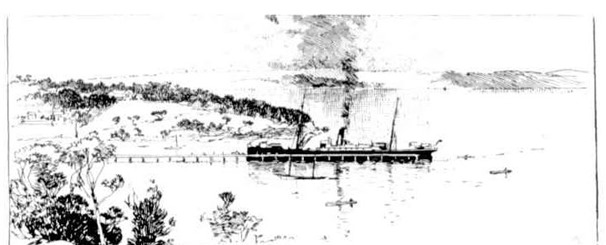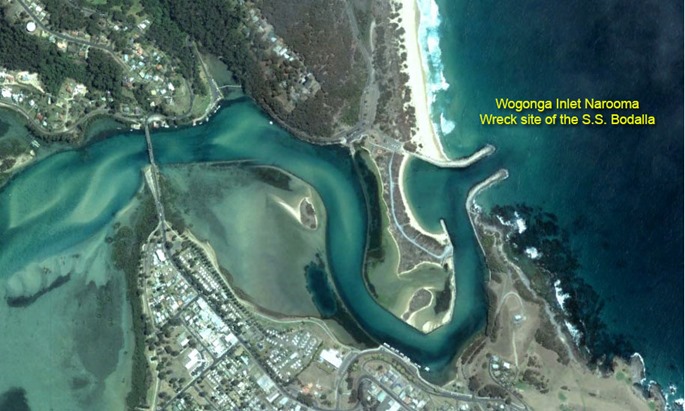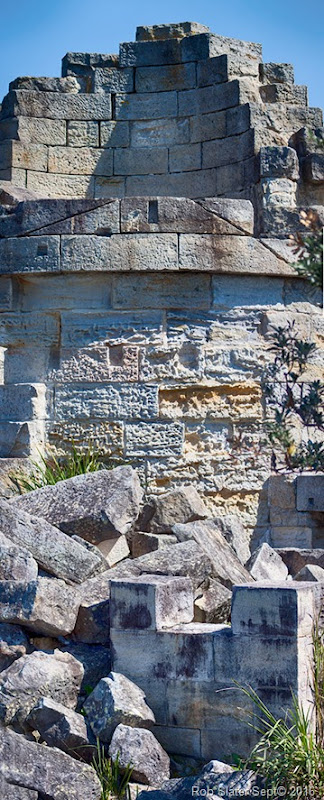29 September 2016
26 September 2016
23 September 2016
Tall ship spotted
22 September 2016
S.S.Eden.
| These are some of the headlines that announced the narrow escape from disaster of the S.S. Eden in 1909.  S,S, Eden in Eden Harbour – no copyright restrictions. |
 |
| In this case it was a slightly strange combination of circumstances that caused the mishap and near disaster of the Luxuriant Steam Ship Eden. Saturday 18th 1909 Sailing on smooth seas between Eden and Sydney, the S.S Eden carried 100 passengers including 40 to 50 women and children and around 30 crew, and cargo, Captain S.Bishop who was temporarily relieving Captain G. Walker, was staying closer in to shore than would normally have been regarded as prudent or necessary. The second unusual circumstance. 7 - 8a.m - Ulladulla light had been shortly spotted, the Eden cut straight across Wreck Bay and kept close in. Breakers Ahead - The man on lookout saw the cliffs and rushed aft, the captain in the wheel house ordered the the engines to be put into full speed astern, but it was to late, and the steamer crashing on, was brought upon the rocks. The Eden responded to her engines and was backed off straight away, an examination showed that the fore-peak had become flooded, the bulk head kept the remainder of the vessel perfectly tight. The ship was examined and found to be badly damaged below the water line Captain Bishop judged the Eden to be sea worthy and without delay headed the Eden away for Sydney. The wells were sounded periodically during the run up the coast, and it was found that the water had not extended to the holds, the pumps were not required, and consequently the cargo was not damaged. The Eden was fitted with two bulkheads and therefore if the damage had been much greater than it proved to be she would have remained afloat. Miraculous Escape. Damage Report.  REF: http://www.photosau.com.au/cos/scripts/ExtSearch.asp?SearchTerm=089597 Captain S. Bishop one of the oldest and most careful of the coasting masters was temporarily relieving Captain G Walker at the time of the accident, but it had been arranged that he should take over permanent command of the vessel. Captain Walker having been selected to command the companies new luxuriant steamer Merimbula, which in 1928 went ashore and sunk after running into Drum and Drumsticks near Jervis Bay. Continue reading about the Merimbula Other reported incidents involving the Eden. 1905 - The Eden had previously survived a tremendous gale off the coast of Jervis Bay. Seeking shelter in Jervis Bay, the Eden entering the bay with great difficulty, she took four hours to pick up the lighthouse, Sea after sea broke over the steamer, smashing the fittings and saloon furniture. The passenger of whom there were a large number had an exciting time, and the women suffered severely, weeping and praying all night. The weather was so tempestuous that the female passengers were not the only ones on board who thought the Eden would never survive the storm. 1910 - Tidal Wave. 1921 -- The Eden was used to carry cargo and passengers to relieve Tasmania which was cut off during a seaman’s strike. 1929 - Man Lost Overboard. |
| |
| Meaning: |
 The red hawsepipe can be clearly seen in the bow of the Lady Denman Ferry. |
| |
18 September 2016
15 September 2016
Cape St George.
14 September 2016
French lighthouse keepers changing shift.
| Amazing footage taken at the French Lighthouse Kereon, built in 1914 in the Iroise Sea, despite continued rough conditions. Kereon was automated in 2004. |
| The Cape St George Lighthouse and Point Perpandicular Lighthouse have both featured on this blog site on many occasions. When we visit the ruins of the Cape St George lighthouse we marvel at the isolation and effort the pioneers would have had to endure to keep the families and the lighthouse running. I found this video of the French lighthouse keepers changing shifts during gale force winds. The lighthouse itself is a marvel of engineering, the skill of the boat master in the dangerous conditions is amazing, and worth the small time it takes to watch the film. |
13 September 2016
Crookhaven Heads.
| Wrecks and Melancholy. | |||
|
| |||
| 1858 – The Schooner Mountsbay. Once the news of the wreck was known, Captain M’Cue of the Steamer Nora Creina, sent out his lifeboat, manned by a portion of his crew and two volunteers ashore, who were accompanied by Mr. Barker, mate of the steamer and Mr. W.C. Morrison of Greenwell Point. Fortunatly these parties saved all the cargo but the schooner became a total wreck. - All hands were saved.. 1864 - The Barque Pacific, During devastating floods and gales that inundated the farms and towns of the Nowra Shoalhaven region, two vessels were lost . The 313 ton American Built Barque Pacific, property of Mr.. William Wright, of Sydney, under the command of Captain Chase became a total wreck at Crookhaven heads. The beach below the Crookhaven Heads was strewed with candles. 1864 – The Ketch Sarah, from Sydney was lost at Crookhaven Heads during the same storm as above - one man was lost after being washed from the helm. 1873 – The S.S. Coolangatta, paddle steamer, 87 tons, during floods and in ballast she parted from one sea anchor and dragged the other. She was swept out of the river and capsized, the crew escaped with great difficulty in their boat. She was later picked up, bottom upwards and during an attempt to tow her into the Crookhaven River and right her, she sank in deep water. 1901 - The Ketch Chippewa 26 tons, wrecked at Crookhaven Heads during a heavy gale – reports indicate that all hands were lost, she lay in about 60ft of water and attempts were made to salvage her, but when the cables gave away, she went to pieces. . 1907 - The S.S. Allowrie, grounded at Crookhaven Heads on the 30th. But since floated off and apparently undamaged. Allowrie crossing the bar 1905. 1908 – The S.S. Peterborough, 159 tons, built by Atlas Engineering Co., Woolwich, New South Wales for the Shellharbour S N Co Ltd. grounded near Crookhaven Heads, but was not in a dangerous position and was refloated on the next high tide.  3- Crookhaven pilot station opposite the breakwater. 3- Crookhaven pilot station opposite the breakwater. 4 - Quarry from which the stone is obtained. It is about 200 yards from the shoalhaven bridge, and the stone has to be hauled about twenty miles to the breakwater. 4 - Quarry from which the stone is obtained. It is about 200 yards from the shoalhaven bridge, and the stone has to be hauled about twenty miles to the breakwater.5 – Crookhaven Lighthouse. 1911 – S.S. Coomonderry – 147 tons steel steam ship, Aground as Crookhaven Heads - at this time the entrance to the river was very badly silted, going from, and coming into the river posed many challenges without the added pressure of the river becoming to shallow to cross except on dead high tide. After being grounded Captain Willes was so concerned he wrote a report to the South Coast Steam Navigation Company, Ltd; outling his fears. | |||
REF: http://eheritage.statelibrary.tas.gov.au/resources/detailb433.html?ID=CHH_00635   Stranded on the shore in Bernie Tasmania. | |||
| 1912 – The S.S. Brooklyn, Wrecked at Crookhaven Heads, crew of 8 saved...continue To previous post about the S.S. Brooklyn. 1936 - A launch, skippered by Mr. Hope Bartlet and accompanied by his mechanic, Mr. Frank Ball, left Crookhaven River at night, soon after leaving the entrance the weather changed, the sea began to rise in front of a developing north east gale,,,motoring for some time without making any headway and starting to ship a sea or two, it was decided they should return to the safety of the river. Trying to enter the river in total darkness, the launch ran right up onto rocks smashing a hole. The men managed to find safety by scrambling across the rocks and getting ashore,. The vessel became a total wreck. | |||
8 September 2016
Crookhaven Heads–The S.S Bodalla
| The Shoalhaven has many ports of call for coasting vessels, each port entrance poses it’s own challenge to the captains and crew during foul weather and one of the more dangerous is Crookhaven Heads, particuarly before the breakwater was built in 1910. |
 |
| Thursday the 13th of May 1923 |
| 1914 . S.S. Bodalla was launced and was owned by the Illawarra and South Coast Steam Navigation Company, Ltd., She was used on the south coast run, often picking up a cargo of Silica rock from Ulladulla. The Bodalla was expressly built for the Moruya and Narooma trade with special provisions for carrying cheese and passengers.  out of copyright. REF:http://nla.gov.au/nla.obj-140705499/view  Her wrecked remains were later sold at auction for 50 pounds to William Waugh Limited of Balmain. At the time of the wreck, the Bodalla was insured for 11.500 pounds. |
 REF: http://www.eurobodalla.com.au/Things-to-See-and-Do/History-and-Heritage/narooma-lighthouse-museum |
Marine Court Enquiry. |
 |
| Update: 2016. |
| Continue to a previous post about the loss of the S.S. Brooklyn at Crookhaven Heads. |
 |
5 September 2016
Sunk off Jervis Bay
The big guns roar during target practice off Jervis Bay. |
| The Navy and Jervis Bay have been linked together since the first tall ships sailed past the 300ft high magestic vertical cliff face of Point Perpendicular, and anchored in the sheltered waters of the bay. A look through this blog site will reveal many interesting facts about the Navy and it's relationship with the bay and the waters around Jervis Bay. |
| The navy to this very day still conduct training exercises in and around the bay, local residents are accustomed to the rumble and vibrations from the war ships when their using the live firing range at Beecroft Peninsula for ship to shore bombing practice. They also use the waters surrounding jervis bay for target shooting. Floating targets are dragged hundreds of meters behind a tow vessel, the big guns roar as they fire their deadly rounds towards the moving target. When navy ships are no longer fit for active service, the navy sometimes uses this opportunity to build on their skills by using the stripped out hulks for target practice. |
| The first was the HMAS Kara Kara, she was sunk on the 31st of January 1973, after serving as a target for ships and aircraft.. |
 |
| The second vessel was Bathurst class minesweeper, HMAS Colac - she was sunk off Jervis Bay on 4th March 1987. |
 |
| The life and times of these two vessels is a fascinating story in itself, follow the links below for more information. |











 S.S. Peterborough.
S.S. Peterborough. 

